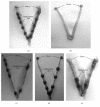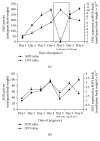Antiestrogenic and Anti-Inflammatory Potential of n-Hexane Fraction of Vitex negundo Linn Leaf Extract: A Probable Mechanism for Blastocyst Implantation Failure in Mus musculus
- PMID: 27351007
- PMCID: PMC4897515
- DOI: 10.1155/2014/241946
Antiestrogenic and Anti-Inflammatory Potential of n-Hexane Fraction of Vitex negundo Linn Leaf Extract: A Probable Mechanism for Blastocyst Implantation Failure in Mus musculus
Abstract
The anti-implantation potential of different fractions of Vitex negundo Linn leaf extract was evaluated in female Swiss Albino mice. Animals from different groups were dosed orally either with 0.2% agar (vehicle) or with fractions of V. negundo leaf extract (n-hexane, chloroform, n-butanol, and remnant fractions) at 10:00 a.m., from day 1 to day 6 of pregnancy. The pregnant females from each group were sacrificed on different days of pregnancy (n = 6), and uterus was excised and used for estimation of lipid peroxidation and assay of superoxide dismutase activity as a marker for blastocyst implantation. Animals treated with n-hexane fraction showed altered level of superoxide anion radical and superoxide dismutase activity as compared to control animals. The probable mechanism by which this extract exhibits inhibition of blastocyst implantation is through the anti-inflammatory and antiestrogenic potential.
Figures





Similar articles
-
Anti-inflammatory, Anti-estrogenic, and Anti-implantation Activity of Bergia suffruticosa (Delile) Fenzl.Pharmacogn Mag. 2015 Oct;11(Suppl 3):S407-13. doi: 10.4103/0973-1296.168973. Pharmacogn Mag. 2015. PMID: 26929574 Free PMC article.
-
Blastocyst implantation failure in mice due to "nonreceptive endometrium": endometrial alterations by Hibiscus rosa-sinensis leaf extract.Contraception. 2005 Mar;71(3):227-30. doi: 10.1016/j.contraception.2004.10.004. Contraception. 2005. PMID: 15722074
-
A possible role of superoxide anion radical in the process of blastocyst implantation in Mus musculus.Biochem Biophys Res Commun. 1989 Jun 15;161(2):762-70. doi: 10.1016/0006-291x(89)92665-x. Biochem Biophys Res Commun. 1989. PMID: 2544172
-
Vitex negundo Linn (VN) leaf extract as an adjuvant therapy to standard anti-inflammatory drugs.Indian J Med Res. 2006 Oct;124(4):447-50. Indian J Med Res. 2006. PMID: 17159267
-
Final report on the safety assessment of capsicum annuum extract, capsicum annuum fruit extract, capsicum annuum resin, capsicum annuum fruit powder, capsicum frutescens fruit, capsicum frutescens fruit extract, capsicum frutescens resin, and capsaicin.Int J Toxicol. 2007;26 Suppl 1:3-106. doi: 10.1080/10915810601163939. Int J Toxicol. 2007. PMID: 17365137 Review.
Cited by
-
Screening of Optimal Phytoconstituents through In silico Docking, Toxicity, Pharmacokinetic, and Molecular Dynamics Approach for Fighting against Polycystic Ovarian Syndrome.Curr Pharm Des. 2025;31(26):2085-2104. doi: 10.2174/0113816128330398241015115043. Curr Pharm Des. 2025. PMID: 39513314
-
Anti-inflammatory, Anti-estrogenic, and Anti-implantation Activity of Bergia suffruticosa (Delile) Fenzl.Pharmacogn Mag. 2015 Oct;11(Suppl 3):S407-13. doi: 10.4103/0973-1296.168973. Pharmacogn Mag. 2015. PMID: 26929574 Free PMC article.
References
-
- Pal A. K., Bhattacharya K., Kabir S. N., Pakrashi A. Flowers of Hibiscus rosa-sinensis, a potential source of contragestative agent: II. possible mode of action with reference to anti-implant effect of the benzene extract. Contraception. 1985;32(5):517–529. doi: 10.1016/0010-7824(85)90021-6. - DOI - PubMed
-
- Psychoyos A. Endocrine control of egg implantation. In: Greep R. O., Astwood E. B., editors. Handbook of Physiology, Section 7, Endocrinology. Vol. 2. Washington, DC, USA: American Physiological Society; 1973. pp. 187–215.
LinkOut - more resources
Full Text Sources
Other Literature Sources

